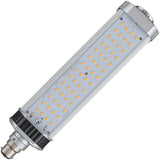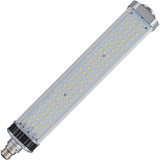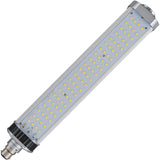Use These Outdoor Lighting Guidelines to Avoid Common Mistakes
Posted by Dave on for ProLampSales

Outdoor lighting, whether landscape or building mounted, can add significant visual appeal to both commercial and residential buildings and spaces. When designed and implemented properly, lighting around a building enhances the architecture, showcases plants, rocks and sculpture in the landscape and guides visitors safely to the entrance. In addition, exterior building lighting can improve security.
However, it is also easy to end up with outdoor lighting that does none of the above.
This post will present a few basic guidelines that will help you avoid the common pitfalls of exterior lighting.
Guideline 1: Choose building mounted fixtures with diffusers, lenses or shields that hide the light bulb from people as they approach the building.
If the light source (bulb) can be seen, chances are the viewer will experience glare. This applies to both building mounted fixtures as well as landscape fixtures. Post top fixtures with clear glass commonly produce glare. Traditional lantern style porch lights with clear glass can produce so much glare as to make it difficult to look at the entry door when it is approached. Pagoda style landscape or path lights can work as long as there is no slope or steps where a person could be below the fixture, in which case light coming through the clear pagoda glass could easily cause glare. Select fixtures that use frosted or tinted glass diffusers or fixtures that are built to shield the light source from people when standing or sitting in the illuminated environment.
Guideline 2: Too much illumination of a landscape or the building can cause unsightly conditions. Choose a light level that is just bright enough.
There are two causes of too much light: high wattages (for example using a 50 watt halogen bulb when a 20 watt will be visually more appealing) and too many fixtures, too close togther - usually a landscape lighting problem. We have all seen path lights lined up every two feet along a walkway to a home. Not only is the look not good, it is completely unnecessary. Every inch of a walkway does not need to be illuminated for safe passage. The purpose of path lights is to provide just enough light to mark a reasonable distance forward for a straight path or to mark an upcoming turn in the path. As for high wattage, it is usually easy to try different wattage bulbs in the fixtures until the amount of illumination meets the minimum required to be functional. Finding this minimum level will usually result in the most aesthetic lighting.
Guideline 3: Colored lights create an unrealistic look in a landscape.
While color has been embraced in commercial outdoor floodlighting that washes the façade of a building, it does not work for path lights or accents on plants and trees in the landscape. Avoid color.
Guideline 4: Think ahead and try to avoid putting a landscape light too close to a plant which can cause both too much light on the foliage (glare), and, if the plant grows, cause foliage to cover the fixture and make it useless.
Ground mounted floodlights can cause unsightly over-illumination on plant foliage when aimed directly at the plant or trees that are only a short distance from the flood light. Also, in a few years plants can grow to the extent that they cover a ground mounted landscape light. Either plan on annual pruning to keep the fixture from being obscured, or, re-position the fixture.
Guideline 5: Post top and wall mounted light fixtures should be designed with a built-in light "cut-off" as part of the fixture so that no light, or very little light, can escape up toward the sky.
Many municipalities have night sky pollution codes modeled after one from the International Dark Sky Association. These codes requires help preserve the human experience of enjoying the night sky. Properly shielded building mounted fixtures also reduce the chance of light trespass into a neighbors yard or onto their house. When placing fixtures on the side of a building, focus on the purpose for the light. For example, if security over a door is the objective, the light only needs to go straight down from a fixture mounted over the door. Any light that goes up above or horizontally away from the target zone can result "light pollution".
Guideline 6: Chose a fixture size that is compatible with the size of the building or the landscape.
Oversized or undersized fixtures can be a distraction because they appear out of place. Whether building mounted or in the landscape, carefully select a fixture size that will blend in with the architecture or landscape design rather than call attention to itself.
Well designed outdoor lighting creates a pleasing environment for people both visually and functionally. Follow these basic guidelines to avoid common mistakes that can detract from your outdoor nighttime setting.
- Posted in Landscape & Outdoor
Featured Products (View All)
0 Comments




